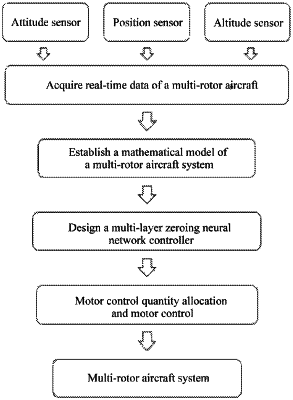| CPC G08G 5/003 (2013.01) [B64C 39/024 (2013.01); G05D 1/0088 (2013.01); G05D 1/0816 (2013.01); B64U 30/20 (2023.01); B64U 2101/00 (2023.01)] | 9 Claims |

|
1. A method for controlling stable flight of an unmanned aircraft, characterized by comprising the steps of:
1) acquiring real-time flight operation data of the aircraft itself, analyzing a kinematic problem of the aircraft, and establishing a dynamics model of the aircraft;
2) constructing a deviation function according to the real-time flight operation data acquired in step 1) and target attitude data, and constructing neurodynamic equations based on the deviation function by using a multi-layer zeroing neurodynamic method, wherein the neurodynamic equations based on the deviation function corresponding to all parameters together constitute a controller of the unmanned aircraft, and output quantities solved from differential equations of the controller are output control quantities of motors of the aircraft; and
3) controlling powers of the motors according to a relationship between the output control quantities solved in step 2) and the powers of the motors of the unmanned aircraft to complete motion control over the unmanned aircraft, specifically:
according to a power allocation scheme for the unmanned aircraft, the control quantities solved by the controller have the following relationship with the powers of the motors of the unmanned aircraft:
U=WF
where U=[u1 u2 u3 u4]T refers to the output control quantities of the unmanned aircraft, F=[F1 . . . Fj]T refers to the powers of the motors of the unmanned aircraft, j is the number of the motors of the unmanned aircraft, W is a power allocation matrix of the unmanned aircraft, and the matrix W has different forms depending on different structures and the number of rotors, and needs to be determined according to the structure thereof and the number of the rotors;
the corresponding powers F of the motors are obtained by means of matrix inversion or pseudo-inversion:
F=W−1U
if the matrix W is a square matrix and is reversible, W−1 is obtained by means of an inverse operation, and if W is not a square matrix, W−1 is solved by means of a corresponding pseudo-inverse operation; and the desired powers F of the motors are finally obtained, input voltages of the motors are controlled according to a relationship between the voltages and powers of the motors to control the rotational speeds of the motors, and the control over the powers of the motors is finally realized to complete stable flight control over the unmanned aircraft.
|